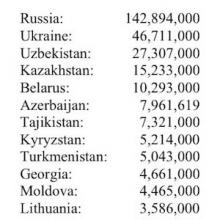Social Structure

Long Teaching Module: Everyday Life in Eastern Europe in the 1980s
Explaining the causes of an event as large, complicated, and significant as the revolutions of 1989 and the end of Communist single-party rule and the Cold War is no small task.

Long Teaching Module: Nationalities and the Breakup of the Soviet Union, 1989-2000
The Soviet Union was a multi-national empire from the revolution of 1917 through the final demise of Communism in 1991.
Warsaw Embassy Cable, Bronislaw Geremek Explains Next Steps Toward a Solidarity Government
Following the historic semi-free elections in Poland in June 1989, which resulted in a near total defeat of the Communist regime, Polish Communist and Solidarity leaders engaged in ongoing and significant negotiations in the hope of establishing stability in Poland.
Czechoslovak Secret Police Memorandum, "Information Regarding the Situation in the CSSR"
As a result of the intensifying public demonstrations in the first half of 1989, the Czechoslovak Communist Party increased its surveillance and suppression of independent and opposition groups, particularly in anticipation of politically-charged anniversaries.
Czechoslovak Secret Police Memorandum, "Information on the Security Situation . . "
This Secret Police (StB) memorandum from 21 August details the plans of independent and opposition groups to commemorate the politically-sensitive anniversary of the 1968 Warsaw Pact invasion, and the police's "extraordinary security measures" to prevent the commemorations from taking place.
U.S. Reaction to a New Prime Minister in Poland
In early June 1989, Poland held its first semi-free elections since the inception of Communist Party rule in the post-World War II era. The elections resulted in a solid defeat of Communism and a sound victory for the Solidarity opposition.
Transcript of the SED Politburo Session held on 5 September 1989 East Germany
Hungary began dismantling the barbed wire along its border with Austria in May, 1989. Over the summer months, thousands of East Germans risked their lives crossing over the Hungarian-Austrian border before heading north to West Germany.
Letter from GDR Ambassador to Hungary, Gerd Vehres, to Foreign Minister Osker Fischer
Hungary began dismantling the barbed wire along its border with Austria in May, 1989. Over the summer months, thousands of East Germans risked their lives crossing over the Hungarian-Austrian border before heading north to West Germany.
National Security Directive 23: United States Relations with the Soviet Union
As President George H. W. Bush took office in January 1989, factions within his administration disagreed concerning the approach to take with regard to US-Soviet relations.
Berlin Embassy Cable, The GDR Political Crisis: Still Deepening. October 4, 1989
On the eve of East Germany fortieth anniversary celebrations, it appeared that the SED was losing control. Several pressure points in society were mounting at the same time.